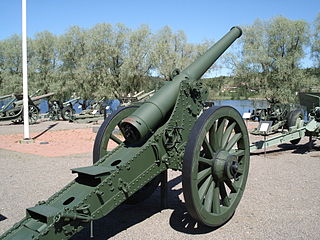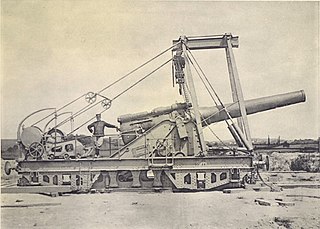
The Canon de 75 Montagne modèle 1928 was a French mountain gun, used by France, Poland and Nazi Germany during World War II.

The Canon de 155 C modèle 1917 Schneider, often abbreviated as the C17S, was a French howitzer designed by Schneider. It was essentially the Canon de 155 C modèle 1915 Schneider fitted with a different breech to use bagged propellant rather than the cartridge cases used by the older howitzer. It was used by France, Russian Empire, Belgium, Romania, and the United States from 1917 during World War I and was widely exported after the war. Surviving weapons were in service with France, Poland, Greece, Italy, Belgium, the United States, and Finland during World War II. Captured weapons were used by the Germans for their 2nd-line artillery and coast defense units.

The Canon de 155 C modèle 1915 Saint-Chamond was a French howitzer used during World War I. It was based on a private prototype of a 150 millimetres (5.9 in) howitzer presented to the Mexican government in 1911. The French government ordered 400 Saint-Chamond howitzers in 1915, these being delivered starting in late 1916. Small numbers of Saint-Chamond howitzers were given to the Serbian and Romanian armies towards the end of World War I. The Saint-Chamond howitzer served in the French Army after World War I and were mobilised at the outbreak of World War II. Finland bought 24 Saint-Chamond howitzers during the Winter War and these served until the 1960s. The German Army captured some Saint-Chamond howitzers after the fall of France and used these mostly as coastal defence guns until the end of World War II.

The 152 mm howitzer Model 1910 Schneider or, more properly, 6 dm polevaja gaubitsa sistemy Schneidera as it was designated in Tsarist times, was a French howitzer designed by Schneider et Cie. It was used by the Russian Empire and the Soviet Union during World War I, the Polish–Soviet War and the Russian Civil War. Finland captured nine during the Finnish Civil War, but did not use them during that conflict. They did see combat during the Winter War and the Continuation War.

The Canon de 75 contre avion modèle 1940 Schneider was a French 75 mm anti-aircraft gun designed and manufactured by Schneider et Cie at Le Creusot. These guns were used by the French Army during the Second World War.

The de Bange 155 mm long cannon mle. 1877 was the French artillery piece that debuted the 155 mm (6.1 in) caliber, which is still in widespread use across the world today. Although obsolete by the beginning of World War I, the 155 L de Bange was nonetheless pressed into service and became the main counter-battery piece of the French army in the first two years of the war.

The Canon de 75 antiaérien mle 1913–1917 were a family of French 75 mm anti-aircraft guns designed and manufactured by Schneider et Cie at Le Creusot. The guns were used by the French Army during the First World War and Second World War.

Canon de 145 L modèle 1916 Saint-Chamond or 145 L 16 was a French heavy artillery piece designed and produced during the First World War. From 1918, many were rebored to use 155 mm shells and renamed Canon de 155 L modèle 1916 Saint-Chamond. A number of 145 and 155 guns were still on hand during the Second World War and served as coastal artillery in the French, Italian and German services.

The Mortier de 220 mm Tir Rapide modèle 1915/1916 Schneider or 220 mm TR mle 1915/1916 was a French howitzer designed and produced during the First World War. A number were still on hand during the Second World War and served in Belgian, French and German service.

The Canon de 155 L modèle 1918 Schneider was a French heavy artillery piece designed and produced during the First World War. A number were still on hand during the Second World War and served in French and German service.

The Mortier 280 mm TR de Schneider sur affût-chenilles St Chamond was a French self-propelled siege howitzer designed during the First World War and used during the Second World War.

The Canon de 155 L modèle 1877/14 Schneider was a French heavy artillery piece designed before and produced during the First World War. A number were still on hand during the Second World War and served in the French and German services.

The Canon de 120 mm L modèle 1878 was a French piece of siege and field artillery which was widely used during the First World War and despite its obsolescence, it was still in use by some nations during the Second World War.

The Canon de 32 modèle 1870/93 à glissement was a French railway gun used by the French Army during World War I and World War II.

The Canon de 274 modèle 87/93 à glissement was a French Railway gun used by the French Army during World War I and World War II. The Germans captured a number after The Fall of France and operated them throughout the war.

The Canon de 240 TR Mle 1903 sur affût-truck Mle 1914 was a French railway gun and siege gun used by the French Army during World War I.

The Canon de 305 modèle 1893/96 à glissement was a French railway gun that saw action during World War I. These guns were rebored late in the war and held in reserve between the wars then mobilized by France during World War II.

The Canon de 32 modèle 1870/81 à glissement was a French Railway gun used by the French Army during World War I and World War II.

The Canon de 32 modèle 1870/84 à glissement was a French Railway gun used by the French Army during World War I and World War II.

The 120 mm Armata wz. 78/09/31 and 120 mm Armata wz. 78/10/31 were field guns produced and used by Poland during World War II and Finland during the Continuation War.
























